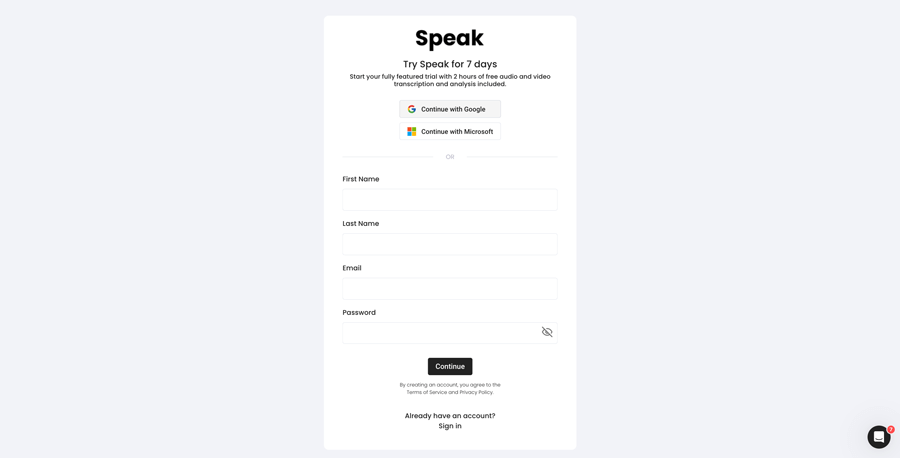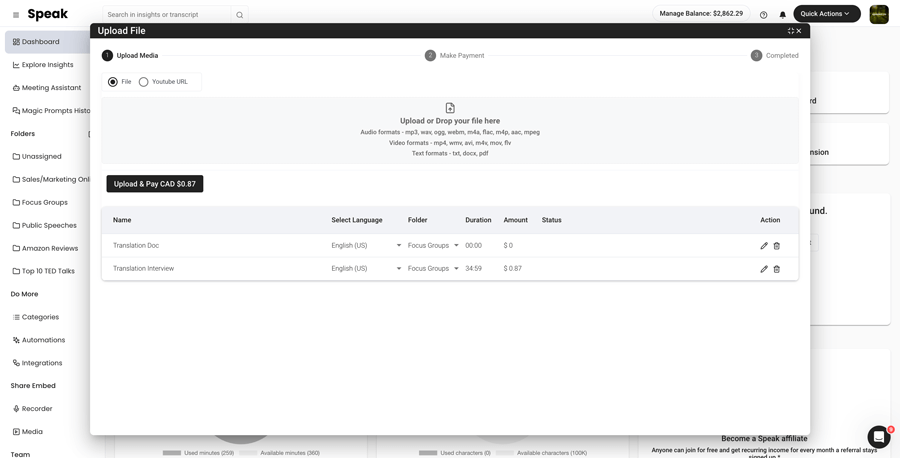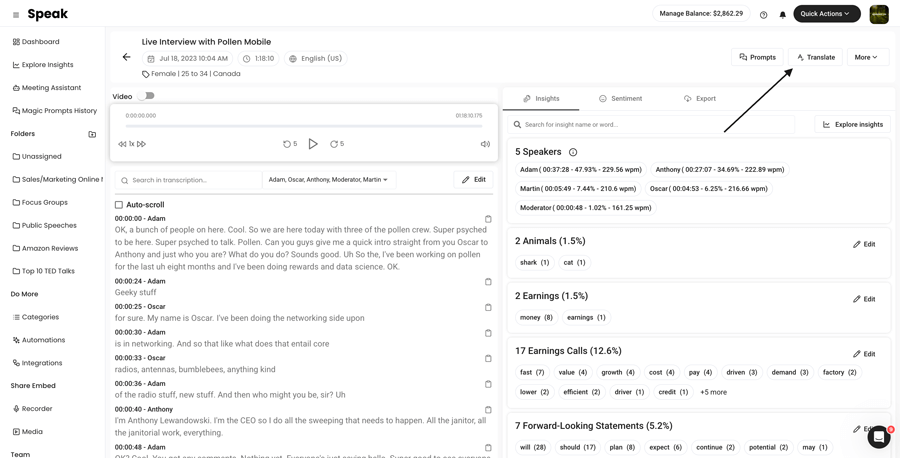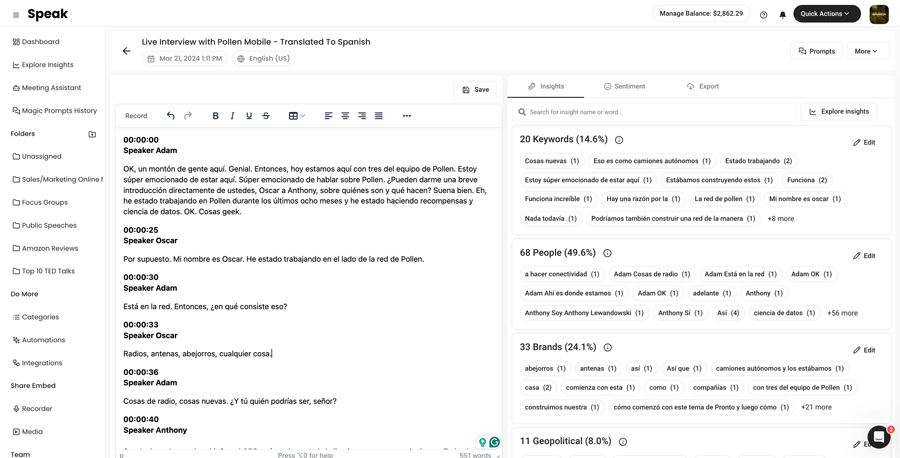How To Translate Japanese to English (Indian)
Translating Japanese to English (Indian) is super simple!

Step 1: Register for Speak
Register for Speak using this link.
Once you register, you can instantly begin translating your Japanese to English (Indian) file(s).

Step 2: Upload Your Japanese file(s)
As soon as you log in, you will be redirected to the dashboard.
Once there, you can select the Quick Action "New Upload".
In Speak, you can seamlessly upload, transcribe and translate audio, video and text files all at once!

Step 3: Translate Your Japanese file(s) to English (Indian)
Once the file is uploaded, simply visit your file and select "Translate".
If it is an audio and video file, Speak will ask you if you want to keep the speaker names and timestamps in the translation.
Want to translate many files at once? No problem!
You can view the files you want to automatically translate from Japanese to English (Indian) from the folder level and instantly translate as many files as you need with our artificial intelligence translation in just a few clicks.

Step 4: That's It! View, Analyze, Modify & Export Your New English (Indian) file(s)
Once the translation is done, you will be alerted and you will see a new document in the same folder your original file is in.
The file will be named the same but with a dash indicating that it is the translated version.
Need support with your Japanese translation?
We are always here and happy to help at Speak!
Just send us a message on live chat on the bottom right corner and we will ensure you are set up for success.
Interested in translating Japanese or other languages to different languages? View our entire list of supported translation languages here.
Automatic, accurate, instant AI translation from Japanese to English (Indian) is here for you.
Register for Speak using this link and begin translating Japanese to English (Indian) today.
Unlocking Global Opportunities: Translate Japanese to English (Indian)
In today's globalized economy, breaking language barriers has never been more critical. With the power of AI translation, businesses and researchers can bridge the linguistic gap between Japanese and English (Indian), unlocking a myriad of opportunities. Speak AI, an NLP and transcription software company, is at the forefront of this technological revolution, facilitating seamless communication and understanding across cultures.
The Power of AI Translation for Businesses and Researchers
AI translation has revolutionized how we interact with different languages, making it easier and more efficient to translate audio, video, and text from Japanese to English (Indian). This advancement holds particular significance for businesses looking to expand into the Japanese market and for researchers aiming to access a wealth of knowledge in Japanese academic resources.
Cost and Time Efficiency
One of the primary advantages of AI-powered translation is the significant cost and time savings it offers. Traditional translation methods are often time-consuming and expensive, requiring the expertise of bilingual professionals. Speak AI's translation software, powered by advanced NLP and large language models, automates the translation process, drastically reducing turnaround times and cost.
Enhanced Accuracy and Context Understanding
The integration of generative AI into Speak AI’s translation tools ensures not only word-for-word translation but a nuanced understanding of context, idioms, and cultural intricacies. This leads to translations that are not only accurate but also culturally and contextually relevant.
Broadening Research Horizons
For researchers, AI-powered Japanese to English (Indian) translation opens up a vast pool of knowledge and data, previously inaccessible due to language barriers. This expands research horizons, fostering international collaborations and innovations.
Drive Interest and Sign-ups with Speak AI
With over 150K users and a 4.9 rating on G2, Speak AI's translation software is not just a translator; it is a bridge to knowledge, opportunity, and understanding. Researchers and businesses leverage our technology to drive productivity, international cooperation, and growth.
Join the Revolution
Our AI meeting assistant, compatible with platforms like Microsoft Teams, Zoom, Google Meet, and Webex, offers real-time transcription and analysis of meetings in multiple languages, including Japanese and English (Indian). Embrace the cutting-edge technology to enhance your communication and analytical capabilities.
Exploring the Japanese and English (Indian) Language Landscape
Geographical and Demographical Insights
Japanese and English (Indian) languages dominate in distinct geographical and cultural landscapes. Japanese, primarily spoken in Japan, has about 128 million speakers. On the other hand, English, with its Indian variant, serves as one of the official languages of India, spoken by over 125 million individuals. These languages, rich in history and culture, act as vital connectors in the respective regions.
Fun Facts and Cultural Richness
Japanese, known for its complexity and varying politeness levels, contrasts intriguingly with Indian English, which incorporates unique idiomatic expressions and vocabulary from several Indian languages. This intermingling of cultures and languages makes the translation between the two not just a linguistic endeavor but a cultural bridge.
The Synergy Between Japanese and English (Indian)
Differences in Structure and Usage
At the core, Japanese and English (Indian) are linguistically distinct. Japanese structure revolves around subject-object-verb (SOV) order, whereas English (Indian) follows the subject-verb-object (SVO) pattern. Moreover, the use of script is drastically different, with Japanese utilizing three writing systems (Kanji, Hiragana, and Katakana) compared to the Roman alphabet for English.
Navigating Cultural Nuances with AI
Understanding the nuances between Japanese and English (Indian) transcends mere translation; it demands a deep cultural insight. Speak AI's translation software excels in navigating these cultural intricacies, providing translations that preserve the essence and intent of the original message, thereby fostering clearer, more effective international communication.
Conclusion
As globalization continues to knit the world's economies and cultures closer together, the demand for efficient, accurate, and nuanced translation services will only grow. Speak AI stands at the vanguard of this linguistic revolution, offering powerful tools for translating Japanese to English (Indian), among other languages. Embrace the future of communication with Speak AI and transcend language barriers with confidence and clarity.
FAQ Section:
What locations are Japanese and English (Indian) popular?
Japanese is primarily spoken in Japan, while English (Indian) is widely used across India, making it one of the country's official languages.
What are some fun facts about Japanese and English (Indian)?
Japanese consists of three scripts, and the language has distinct levels of politeness. English (Indian) often borrows terms from local languages, making it a unique blend of Indian and Western linguistic traits.
What are the differences and similarities between Japanese and English (Indian)?
The structure of the languages is a primary difference, with Japanese using SOV order and English (Indian) using SVO. Both languages, however, serve as crucial links in their respective cultures and economies, emphasizing the importance of clear and effective translation tools like those provided by Speak AI.
Translate Japanese To These Other Supported Languages:
- Translate Japanese-to-Arabic (Egypt)
- Translate Japanese-to-Arabic (Iraq)
- Translate Japanese-to-Arabic (Israel)
- Translate Japanese-to-Arabic (Jordan)
- Translate Japanese-to-Arabic (Kuwait)
- Translate Japanese-to-Arabic (Lebanon)
- Translate Japanese-to-Arabic (Oman)
- Translate Japanese-to-Arabic (Palestinian Authority)
- Translate Japanese-to-Arabic (Qatar)
- Translate Japanese-to-Arabic (Saudi Arabia)
- Translate Japanese-to-Arabic (Syrian Arab Republic)
- Translate Japanese-to-Arabic (United Arab Emirates)
- Translate Japanese-to-Arabic Modern Standard (Bahrain)
- Translate Japanese-to-Armenian
- Translate Japanese-to-Bulgarian
- Translate Japanese-to-Catalan
- Translate Japanese-to-Chinese (Cantonese, Traditional)
- Translate Japanese-to-Chinese (Simplified)
- Translate Japanese-to-Chinese (Traditional)
- Translate Japanese-to-Croatian
- Translate Japanese-to-Czech
- Translate Japanese-to-Danish
- Translate Japanese-to-Dutch
- Translate Japanese-to-English
- Translate Japanese-to-English (Australia)
- Translate Japanese-to-English (India)
- Translate Japanese-to-English (Ireland)
- Translate Japanese-to-English (New Zealand)
- Translate Japanese-to-English (Scottish)
- Translate Japanese-to-English (South African)
- Translate Japanese-to-English (United Kingdom)
- Translate Japanese-to-English (United States)
- Translate Japanese-to-Estonian
- Translate Japanese-to-Farsi
- Translate Japanese-to-Finnish
- Translate Japanese-to-French
- Translate Japanese-to-French (Canada)
- Translate Japanese-to-German
- Translate Japanese-to-German (Swiss)
- Translate Japanese-to-Greek
- Translate Japanese-to-Gujarati
- Translate Japanese-to-Hebrew
- Translate Japanese-to-Hindi
- Translate Japanese-to-Hungarian
- Translate Japanese-to-Icelandic
- Translate Japanese-to-Indonesian
- Translate Japanese-to-Irish
- Translate Japanese-to-Italian
- Translate Japanese-to-Japanese
- Translate Japanese-to-Kannada
- Translate Japanese-to-Korean
- Translate Japanese-to-Latvian
- Translate Japanese-to-Lithuanian
- Translate Japanese-to-Malay
- Translate Japanese-to-Malayalam
- Translate Japanese-to-Norwegian
- Translate Japanese-to-Persian
- Translate Japanese-to-Polish
- Translate Japanese-to-Portuguese
- Translate Japanese-to-Portuguese (Brazilian)
- Translate Japanese-to-Portuguese (Portugal)
- Translate Japanese-to-Romanian
- Translate Japanese-to-Russian
- Translate Japanese-to-Slovak
- Translate Japanese-to-Slovenian
- Translate Japanese-to-Spanish
- Translate Japanese-to-Spanish (Mexico)
- Translate Japanese-to-Swedish
- Translate Japanese-to-Tamil
- Translate Japanese-to-Telugu
- Translate Japanese-to-Thai
- Translate Japanese-to-Turkish
- Translate Japanese-to-Ukrainian
- Translate Japanese-to-Vietnamese



